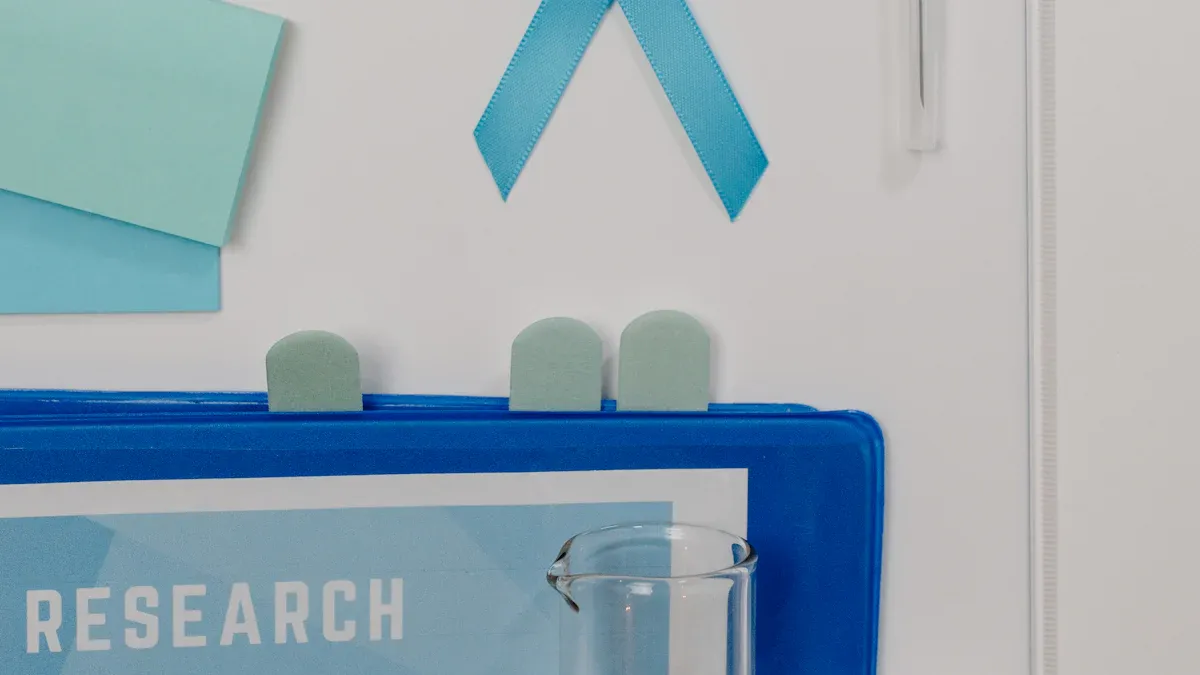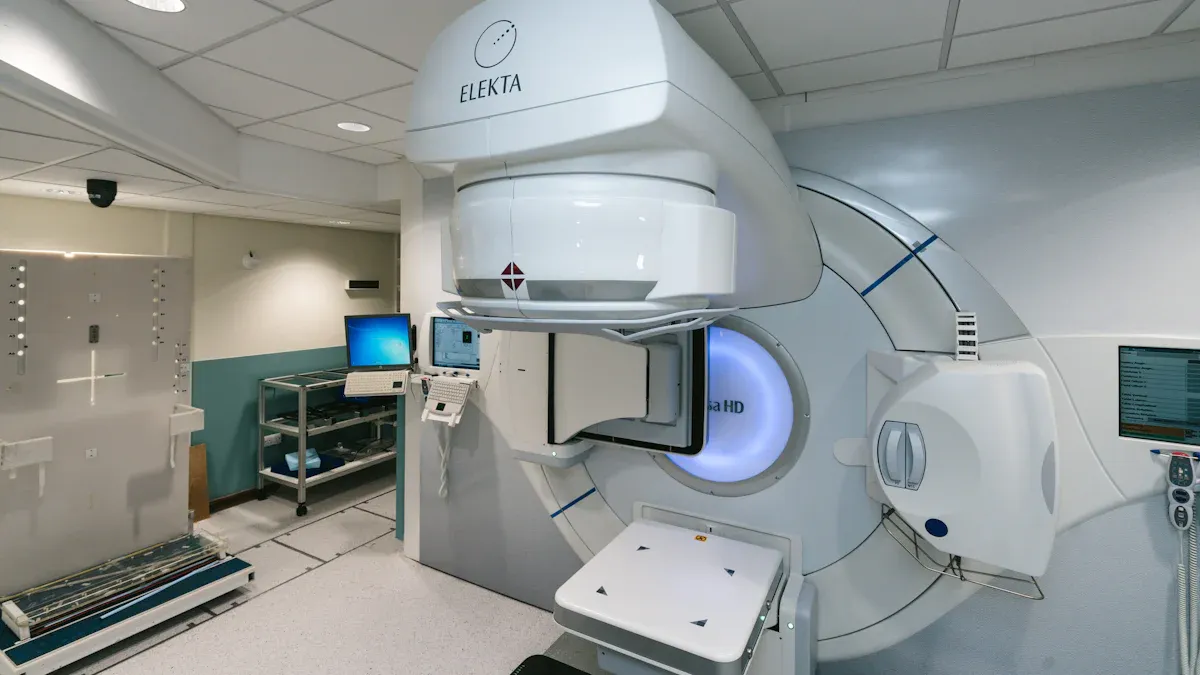Is Chemotherapy the Sole Option for Cancer Treatment

You might ask, "Chemotherapy is the only cancer treatment?" The answer is no. Although chemotherapy is a widely used method, there are other effective treatments such as surgery, radiation therapy, immunotherapy, and targeted therapy. Each treatment is tailored to the type and stage of cancer. For example, surgery can physically remove tumors, while immunotherapy works to strengthen your immune system to combat cancer cells. However, research indicates that patients with nonmetastatic cancers who depend solely on alternative therapies face significantly higher risks. For instance:
Breast or colorectal cancer patients relying on alternative therapies were nearly five times more likely to die.
Lung cancer patients choosing alternatives had more than double the risk of death.
It’s essential to choose a treatment plan that aligns with your health needs and follows medical guidance.
Key Takeaways
Chemotherapy is not the only way to treat cancer. Other options include surgery, radiation, immunotherapy, and targeted therapy.
The best treatment depends on the cancer type and stage. Your overall health also matters. Talk to your doctor for advice.
Some alternative treatments work well, especially for early cancers. Always discuss these choices with your healthcare team.
Chemotherapy can cause tiredness and feeling sick. Managing these side effects can help you feel better during treatment.
Watching and waiting is an option for slow-growing cancers. This lets you avoid extra treatments while keeping track of your health.
Chemotherapy: Purpose and Limitations
What Is Chemotherapy?
Chemotherapy is a treatment that uses drugs to target and destroy cancer cells. These drugs travel through your bloodstream to reach cancer cells in different parts of your body. Doctors often recommend chemotherapy to treat cancers that have spread or cannot be removed with surgery. It can also work alongside other treatments to improve outcomes.
How Does Chemotherapy Work?
Chemotherapy works by attacking cells that divide rapidly, which is a characteristic of cancer cells. The drugs disrupt the cancer cells' ability to grow and multiply. Depending on your situation, chemotherapy may serve different purposes:
Curative chemotherapy aims to eliminate cancer completely.
Neoadjuvant therapy shrinks tumors before surgery.
Adjuvant therapy removes any remaining cancer cells after surgery.
Chemoradiation combines chemotherapy with radiation for better results.
Palliative chemotherapy slows cancer growth and reduces symptoms when a cure is not possible.
This flexibility makes chemotherapy a valuable tool in cancer treatment.
Limitations of Chemotherapy
Although chemotherapy is effective, it has limitations. The drugs cannot distinguish between cancer cells and normal cells that also divide quickly, such as those in your hair follicles, digestive system, and bone marrow. This leads to side effects like hair loss, nausea, and fatigue.
"Chemotherapy is the only cancer treatment?" This is a common misconception. While chemotherapy plays a crucial role, it is not the sole option. Its limitations highlight the importance of exploring other treatments like surgery or immunotherapy.
Additionally, chemotherapy may not work for all cancer types or stages. Some cancers develop resistance to the drugs, making treatment less effective over time. These challenges emphasize the need for personalized treatment plans tailored to your specific condition.
Common Side Effects of Chemotherapy
Chemotherapy can cause side effects because it targets rapidly dividing cells, which include not only cancer cells but also healthy cells in your body. These effects vary from person to person, depending on factors like the type of drugs used and your overall health.
Some of the most common side effects include:
Fatigue: You may feel extremely tired, even after resting. This happens because chemotherapy affects your energy levels and blood cell production.
Nausea and Vomiting: These symptoms occur frequently, but medications can help manage them.
Hair Loss: Chemotherapy damages hair follicles, leading to temporary hair loss.
Infections: Your immune system weakens, making you more vulnerable to infections.
Mouth Sores: The treatment can irritate the lining of your mouth, causing painful sores.
Changes in Appetite: You might experience a loss of appetite or changes in taste.
Research shows that women face a 34% higher risk of severe side effects compared to men. This disparity becomes even more pronounced with immunotherapy, where women have nearly a 50% increased risk of serious complications. These findings come from over 202 cancer clinical trials involving more than 23,000 participants.
You might wonder, "Chemotherapy is the only cancer treatment?" While it plays a significant role, its side effects highlight the importance of exploring other options like surgery or immunotherapy. Discussing these possibilities with your doctor can help you make an informed decision.
Tip: Staying hydrated, eating nutritious meals, and following your doctor’s advice can help you manage side effects more effectively.
Alternative Cancer Treatments

Surgery
Surgery is one of the most direct ways to treat cancer. It involves removing tumors or affected tissues from your body. This method works best for cancers that have not spread to other parts of the body. For example, early-stage breast cancer often responds well to surgical removal.
Patients undergoing surgery alone experience fewer complications compared to those receiving chemotherapy.
Complication rate for surgery: 41%.
These statistics highlight the relative safety of surgery as a treatment option. However, surgery may not be suitable for all cancer types or stages. Your doctor will evaluate your condition to determine if surgery is the right choice for you.
Radiation Therapy
Radiation therapy uses high-energy rays to target and destroy cancer cells. This treatment can shrink tumors, relieve symptoms, or even cure certain cancers. It is often used when surgery is not possible or as a complementary treatment.
Clinical trials, such as NRG-RTOG 0926, demonstrate the effectiveness of radiation therapy.
Evidence Type | Details |
|---|---|
Trial Name | NRG-RTOG 0926 |
Patient Population | Patients with recurrent, high-grade T1 urothelial cancer of the bladder |
Treatment | Trimodality therapy (radiotherapy + radiosensitizing chemotherapy) |
3-Year Freedom from Cystectomy Rate | 88% (CI: 72%) |
Overall Survival at 3 Years | 69% (CI: 54–85%) |
Overall Survival at 5 Years | 56% (CI: 39–74%) |
This data shows that radiation therapy can achieve high survival rates, especially when combined with other treatments.
Immunotherapy
Immunotherapy boosts your immune system to fight cancer. Unlike chemotherapy, which targets all rapidly dividing cells, immunotherapy focuses on enhancing your body’s natural defenses. This makes it a promising option for many patients.
In a phase 2 clinical trial for metastatic breast cancer, personalized immunotherapy showed remarkable results. Three out of six women experienced significant tumor shrinkage. One patient achieved a complete response, while others showed 52% and 69% shrinkage at six and ten months, respectively.
Timing also plays a crucial role in immunotherapy’s success. For instance, patients with stage IIIB-IVC melanoma who received neoadjuvant pembrolizumab followed by adjuvant treatment had a 72% event-free rate at two years. Those who only received adjuvant treatment had a lower rate of 49%.
These findings highlight the potential of immunotherapy to provide effective and personalized cancer treatment.
Note: Discussing these options with your doctor can help you decide the best course of action. Remember, chemotherapy is the only cancer treatment? Not at all. Exploring alternatives like surgery, radiation, and immunotherapy can open up new possibilities for your care.
Targeted Therapy
Targeted therapy focuses on specific molecules or genes that help cancer cells grow and spread. Unlike chemotherapy, which affects all rapidly dividing cells, targeted therapy zeroes in on cancer cells while sparing most healthy ones. This precision reduces side effects and makes it a promising option for many patients.
You might wonder how targeted therapy works. These treatments block signals that cancer cells use to multiply. Some therapies also cut off the blood supply tumors need to grow. Others help your immune system recognize and attack cancer cells more effectively.
Did you know? Targeted therapies can often be used continuously until the tumor progresses. This approach differs from chemotherapy, which is typically limited to shorter durations due to its toxicity.
Studies show that targeted therapies improve survival rates for patients with advanced cancers. For example, they have transformed cancer treatment into a long-term management strategy, similar to chronic disease care. However, long-term use may lead to chronic toxicities, so regular monitoring is essential.
If your cancer has specific genetic markers, targeted therapy could be a game-changer. Discussing genetic testing with your doctor can help determine if this treatment suits your condition.
Active Surveillance
Active surveillance involves closely monitoring your cancer without immediate treatment. Doctors often recommend this approach for slow-growing cancers, such as prostate or thyroid cancer. Instead of starting aggressive treatments right away, you and your medical team track the cancer's progress through regular check-ups and tests.
This method allows you to avoid unnecessary side effects from treatments like chemotherapy or radiation. It also helps maintain your quality of life. However, active surveillance requires commitment. You must attend all follow-up appointments and stay vigilant about any changes in your health.
Tip: Active surveillance works best when the cancer is in its early stages and not causing symptoms. Always consult your doctor to see if this approach aligns with your needs.
By choosing active surveillance, you take a proactive role in your care while minimizing the risks of overtreatment.
Comparing Cancer Treatments

Effectiveness Across Cancer Types
Cancer treatments vary in effectiveness depending on the type and stage of cancer. For instance, chemotherapy often works well for cancers that spread throughout the body, like leukemia or lymphoma. However, targeted therapy may be more effective for cancers with specific genetic mutations.
Studies comparing survival benefits across different cancer types reveal interesting patterns:
Low-risk cancer phenotypes show a 2.3-month shorter survival benefit compared to randomized controlled trials (RCTs).
Medium-risk phenotypes experience a 4.2-month shorter survival benefit.
High-risk phenotypes face a 5.7-month shorter survival benefit.
Additionally, research highlights how pre-existing conditions influence treatment decisions. Linked data from hospitals, primary care, and cancer registries allow for cross-comparisons, ensuring a comprehensive understanding of treatment patterns.
Side Effects and Recovery Time
Each treatment comes with its own set of side effects and recovery timelines. Chemotherapy, for example, often causes fatigue, nausea, and hair loss. Women, in particular, face a higher risk of severe side effects. A study in the Journal of Clinical Oncology found that 65% of patients experienced severe adverse events, with women showing a 66% increased risk of symptomatic side effects during immunotherapy.
Metric | Emulated Trials | RCT Reports | Difference |
|---|---|---|---|
mOS in Treatment Arm | 13% lower | - | - |
mOS in Control Arm | 3% higher | - | - |
RMST Difference (Low-Risk) | Significant in 6/11 | - | - |
RMST Difference (Medium/High-Risk) | Significant in 5/11 | - | - |
Recovery time also varies. Surgery often requires weeks of healing, while radiation therapy may cause fatigue that lasts for months. Immunotherapy and targeted therapy, though less invasive, can lead to chronic side effects requiring long-term management.
Suitability for Different Patients
Your health, age, and medical history play a significant role in determining the best treatment. For example, elderly patients with comorbidities may avoid chemotherapy due to its potential toxicities. Over 50% of advanced lung cancer patients receive no treatment, often due to concerns about pre-existing conditions.
Evidence Type | Description |
|---|---|
Comorbidity Influence | Comorbidities affect treatment choice, adherence, and overall prognosis. |
Treatment Toxicity | Cancer therapy can worsen pre-existing conditions, limiting treatment options. |
Age and Comorbidity | Older patients often skip chemotherapy due to toxicity risks. |
Performance Status | Patients with poor performance status may still benefit from treatment. |
Your doctor will evaluate your overall health and cancer stage to recommend the most suitable option. Remember, "Chemotherapy is the only cancer treatment?" Not at all. Exploring alternatives ensures a personalized approach to your care.
Factors Influencing Treatment Choice
Cancer Type and Stage
The type and stage of cancer play a critical role in determining your treatment plan. Early-stage cancers often respond well to localized treatments like surgery or radiation. For example, early-stage kidney cancer has a favorable prognosis when treated with surgery. However, advanced cancers with widespread metastases require systemic treatments like chemotherapy or immunotherapy. This highlights the importance of diagnosing cancer early to improve outcomes.
Your doctor considers factors like the primary cancer site, tumor size, and whether the cancer has spread. A holistic approach that includes your age, sex, and overall health ensures a personalized treatment plan. This strategy aims to optimize your health outcomes based on your unique situation.
Patient Health and Medical History
Your overall health and medical history significantly influence treatment decisions. Comorbidities, or the presence of other health conditions, can complicate treatment. For instance, they may delay diagnosis, lead to higher tumor stages, or even result in withholding certain therapies due to perceived risks.
Evidence Point | Description |
|---|---|
Comorbidity Impact | Longer diagnostic intervals and higher tumor stages affect treatment choices. |
Treatment Decisions | Significant comorbidities often lead to withholding therapy in advanced cases. |
Performance Status | Trials often exclude patients with poor performance status, limiting options. |
Doctors carefully assess your medical history to balance treatment benefits against potential risks. This ensures that your treatment plan aligns with your overall health and maximizes its effectiveness.
Personal Preferences and Quality of Life
Your preferences and quality of life also shape your treatment choices. Some patients prioritize preserving physical appearance or avoiding invasive procedures. Others may focus on reducing anxiety or maintaining sexual health. Research shows that women choosing mastectomy often experience higher anxiety and depression compared to those opting for breast conservation.
Factor | Mastectomy Group | Conservation Group |
|---|---|---|
Tension and Anxiety | Higher (P < .01) | Lower |
Value on Physical Appearance | Lower | Higher (P < .01) |
Your emotional well-being and lifestyle goals matter. Open communication with your doctor helps ensure that your treatment plan reflects your values and supports your quality of life.
Chemotherapy is a common cancer treatment, but it is not the only option. Alternatives like surgery, radiation, and immunotherapy offer effective solutions depending on your condition. Your overall health, cancer type, and stage influence the best choice. For example, comorbidities can affect how well you tolerate certain treatments, as shown below:
Evidence Type | Description |
|---|---|
Comorbidity Influence | Comorbidity affects cancer treatment decisions, interacting with cancer and influencing the tolerability or effectiveness of treatment. |
Personalized care ensures the best outcomes. Consulting your medical team helps you explore all options and make informed decisions. Remember, chemotherapy is the only cancer treatment? Not at all.
FAQ
What factors determine the best cancer treatment for you?
Your doctor considers your cancer type, stage, and overall health. They also evaluate your medical history and personal preferences. These factors help create a treatment plan tailored to your needs.
Tip: Always discuss your goals and concerns with your doctor to ensure the best care.
Can alternative treatments replace chemotherapy entirely?
Alternative treatments like surgery or immunotherapy can sometimes replace chemotherapy. This depends on your cancer type and stage. For example, early-stage cancers may respond well to surgery alone.
Note: Always consult your medical team before deciding to skip chemotherapy.
Is immunotherapy suitable for all cancer patients?
Immunotherapy works best for cancers with specific markers. It may not suit everyone, especially if you have autoimmune conditions. Your doctor will assess your eligibility based on your health and cancer type.
Did you know? Immunotherapy often has fewer side effects than chemotherapy.
How can you manage chemotherapy side effects?
You can manage side effects by staying hydrated, eating nutritious meals, and following your doctor’s advice. Medications can also help control nausea and other symptoms.
Common Tips:
Rest when needed.
Avoid infections by practicing good hygiene.
Report severe side effects to your doctor immediately.
Is active surveillance a safe option?
Active surveillance is safe for slow-growing cancers like prostate or thyroid cancer. It involves regular check-ups to monitor your condition. This approach avoids unnecessary treatments and their side effects.
Reminder: Active surveillance requires commitment to follow-up appointments and tests.
See Also
Choriocarcinoma: Definition, Symptoms, And Treatment Options Explained
An In-Depth Overview of Various Cancer Types Available
Recognizing Duodenal Cancer: Symptoms And Available Treatments
Choroid Plexus Carcinoma: Key Symptoms And Treatment Insights
Cholangiocarcinoma: Essential Features And Treatment Approaches
